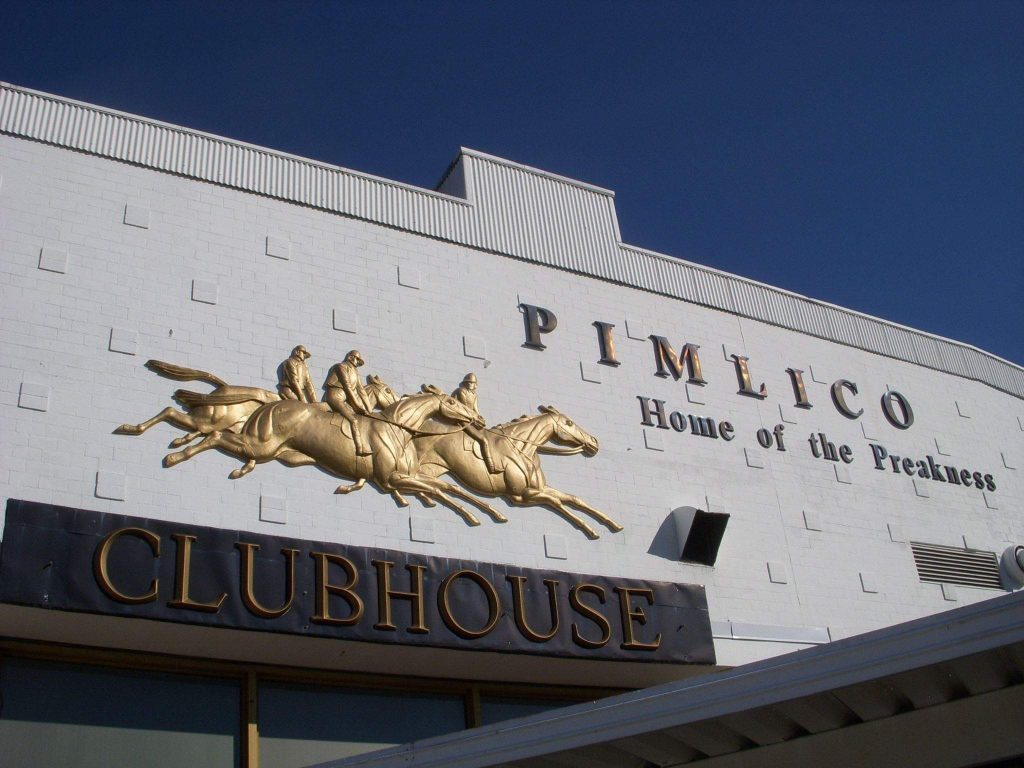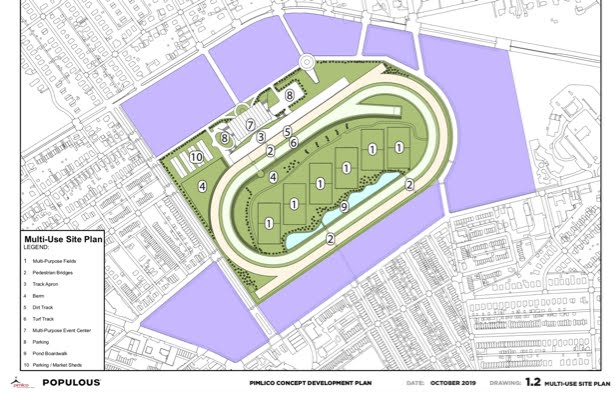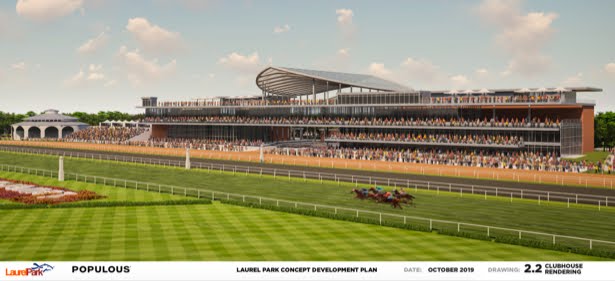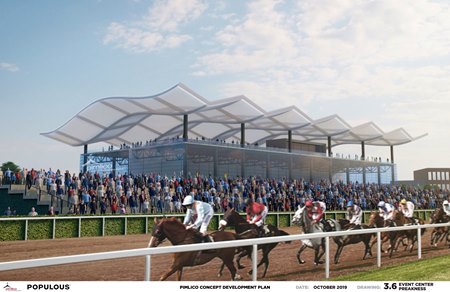
Iconic golden horses on the facade of Pimlico’s clubhouse
On Thursday, a long-awaited bill to reinvigorate the Maryland horse racing industry became law without the Governor’s signature. Gov. Hogan chose to neither sign nor veto the bill allowing the legislation that was unanimously passed by the State Senate in March to become law on June 1, 2020.
Gov. Larry Hogan announced Thursday that a number of other bills would be vetoed due to the large costs affiliated with each. The state has been spending more money, including from its rainy day fund, to combat the coronavirus. Among the 20 bills vetoed are the Kirwan Commission and Blueprint For Maryland’s Future and another bill that authorized $580 million toward Maryland’s Historically Black Colleges & Universities otherwise known as HBCUs.
Better known as “The Racing and Community Development Act of 2020” (SB987/HB1056) this legislation will fund the complete renovations of Pimlico Race Course in Baltimore, Maryland, and Laurel Park Racetrack in Anne Arundel County, Maryland.
Alan M. Rifkin, Esq., counsel for the Maryland Jockey Club (MJC) and Preakness Stakes responded to the announcement Thursday:
“On behalf of Belinda Stronach, The Stronach Group, the Maryland Jockey Club and the Maryland racing industry, we are very appreciative that the “Racing and Community Development Act” is now law. We thank Governor Hogan, Senate President Ferguson, Speaker Jones, Mayor Young, County Executive Pittman and the many other state leaders who championed this historic law.
We are confident that the near shovel-ready capital works projects included in the “Racing and Community Redevelopment Act” will be a critical part of Maryland’s financial recovery, jobs creation and community and economic development.”
With funding in place, ownership of Pimlico will be transferred from The Stronach Group (TSG) to the City of Baltimore or possibly to the Maryland Stadium Authority upon recommendations of some legislators. Ownership of Laurel Park will transfer to Anne Arundel County whose current County Executive is Steuart Pittman, founder of the Retired Racehorse Project and owner of Dodon Farm in Anne Arundel County.
“The Act, which addressed vexing issues that had long challenged the industry, now allows for the bright future and optimism of the Preakness at Pimlico for generations to come, year round racing at Laurel Park making it the epicenter of training and racing in the Mid-Atlantic, and the unprecedented reinvestment in the communities of interest served by the tracks.
This is truly a defining moment in the history of the Maryland thoroughbred racing industry and the State, and we are most appreciative,” Rifkin stated
Under the agreement, TSG will retain ownership of The Preakness Stakes, the Woodlawn Vase and the Maryland Jockey Club. TSG would sign a 30-year lease deal to hold the Preakness at Pimlico, two months for set up and breakdown and pay $10 million a year for overlay for Preakness seating and accommodations such as temporary barns and hospitality.
The legislation requests $180 million for Pimlico, opened in 1870, and $155 million for Laurel Park, opened in 1911, to raise and rebuild both facilities from the ground up. Funding will be in the form of bonds sold through the Maryland Stadium Authority, monies from the Lottery and slots through the Racetrack Facility Renewal Account (RFRA). The bonds are required to be paid within 30 years.
All of Laurel’s 193 acres will be dedicated to development related to the track. There will be a modern, state-of-the-art grandstand built with all new barns and backstretch. In addition, there will be a new MARC train station built and bridges connecting the racetrack facility to the new TSG-owned Laurel Park Station multi-use development on the other side of the station. Click here to view the Laurel Concept Plans

Only half of Pimlico’s 110 acres will be related to the racing facility with the remaining surrounding acreage leased or sold for commercial development. Proposed are multi-use housing, a hotel and parking garage for use by Sinai Hospital and a grocery store. The current clubhouse built in 1960 and grandstand built in 1922, 1954 and 1959, will be replaced with a glass civic center/clubhouse. The racing oval will be rotated 30 degrees and shortened to 15/16th of a mile with two chutes. The infield will contain multiple athletic fields, a pond and footbridge. Click here to view the Pimlico Concept Plans

The original 1870 Pimlico clubhouse, known as the Old Members Clubhouse, burned to the ground in June 1966 leaving behind only the weather vane, from 1909, that now resides in Pimlico’s museum. The only part original to Pimlico that still exists is the wrought iron gate that is located at the National Racing Museum and Hall of Fame in Saratoga, New York.
Bowie Training Facility, formerly Bowie Race Track which opened in 1914 with racing ending in 1983 and the training facility permanently closed in 2015, was to be transferred in ownership under the original language of the bill. Part of that facility’s land would be turned over to the Maryland-National Capital Park and Planning Commission for recreational activities, such as hiking and wildlife viewing, and to the city of Bowie and Bowie State University for activities such as baseball and football. However, subsequent amendments provided for the possibility that Bowie could reopen in a training center capacity.
The legislation is not limited to Pimlico, Laurel and Bowie. In fact, it is quite complicated. The legislation also calls for the creation of an Equine Health, Safety and Welfare Advisory Committee under the Maryland Racing Commission.
The Funding
TSG is seeking $389 million for rebuilding both facilities. The legislation would allow up to $375 million worth of bonds to be issued for the projects, though racing officials believe they may need to use only about $348 million in bonds.
The Maryland Stadium Authority would borrow money upfront to pay for most of the work, in the form of bonds that would be sold on the market. Those bonds would be paid back over 30 years using $17 million per year from the Maryland Lottery.
The lottery would be replenished from three sources:
– $5 million annually in money from slot money from the Purse Dedication Account (PDA) referred to as the “horsemen’s contribution.”
– $3.5 million annually in slots money that had been going to community aid in Baltimore.
– $8.5 million annually from the slots-funded Racetrack Facility Renewal Account (RFRA), money that had been set aside for facility capital improvements (due to sunset in 2035).
– The project also would use about $24 million that will be built up and sitting in the Racetrack Facility Renewal Account by March 2021 and $17 million in a one-time payout from the Maryland lottery.
Under Maryland law, the state’s horsemen receive subsidies from slots to supplement purses (PDA), while The Stronach Group receives grants from slots revenues to fund capital improvements (RFRA), as long as plans are submitted beforehand, all terms and deadlines are met and those funds are matched by the company. The proposal would allow those subsidies to be used to underwrite the bonds, which would have a 30-year maturation. That would require a change in existing state law, which guarantees the slots subsidies through the end of 2035, covering less than half of the 30-year term of the proposed bond.
The plan also calls for a break on the sales tax for construction equipment and other materials that will be used in redeveloping of both facilities. Lawmakers have approved a similar sales tax exemption for other large projects in the state.

Laurel Park Goes First
For Laurel, The Stronach Group (TSG) would enter into a ground-lease arrangement with Anne Arundel County or a county-designated entity that would run for at least 30 years. The company would have the option of regaining full ownership of the property at the end of the lease.
Total Project Costs = $173,365,000:
+ Demolition, Infrastructure, Site Work = $47,917,000
+ Barns, Training, Backstretch = $57,270,000
+Clubhouse and Paddock = $68,178,000
Renovated first, Laurel would continue to be the focus of year-round racing in Maryland. Laurel will function as a supertrack and year-round training facility with a Tapeta track added between the turf and dirt tracks, a new modern clubhouse and all new barns and backstretch. The iconic Laurel paddock will be saved and repurposed.
Pimlico’s Turn and The Preakness Is Still Running
TSG would turn Pimlico over to Baltimore City or a city-approved entity such as the Maryland Stadium Authority.
Total Project Costs = $199,547,000:
+ Demolition, Infrastructure, Site Work = $101,302,000
+ Tracks, Infield, Community Spaces = $33,099,000
+ Multi-purpose Clubhouse and Events Center = $65,146,000
Then Pimlico gets a complete overhaul in 2023 and 2024 with the Preakness being held there during construction. Instead of a racing-focused facility, Pimlico would be renovated into a multiuse facility that would be used most of the year for youth sports, festivals and other events.

Pimlico’s expansive physical plant, including the clubhouse built in 1959 and backstretch, will be leveled replaced with a small glass multi-purpose clubhouse surrounded by commercial development on approximately 50% of the property. The racing oval dirt and turf tracks will be rotated and shortened to 15/16th of a mile with two chutes. The infield will be replaced with berms, a pond and footbridge and athletic fields.
The facility will cease to operate as a year-round training facility, will have no barns or dorm quarters on the backstretch. Ship in temporary stables and accommodations will be constructed for the Preakness meet.
According to plans released in October 2019, the new clubhouse would not have fixed seating and would be a hospitality area for guests in reserve grandstand seats. For the Preakness capacity is estimated at 51,500 including various suite and reserved seating options trackside and turfside including accommodations for 8,000 in an infield picnic area, 12,000 reserved seats along the home stretch and 20,000 general admission tickets for access to the infield.
Odds and Ends
The proposal would entail the creation of several new government agencies to manage the properties and construction. The Stronach Group, operating as the Maryland Jockey Club, would receive a license to operate racing at the two tracks contingent upon adhering to current state laws and regulations. MJC would be required to have at least 180 racing days each year, between Laurel and Pimlico.
Past Legislation
In 2019, there were several pieces of legislation before the Maryland House and Senate regarding Pimlico, Laurel and Bowie. A bill (SB883/HB990) was proposed to add Bowie Training Facility to the Racetrack Facility Renewal Account (RFRA) so slots funding could be accessed for improvements for the facility. Another bill (SB878/HB1070) requested $120 million in bonds, $80 million for Laurel and $40 million for Bowie, to be administered by the Baltimore Economic Development Corporation (MEDCO) with the debt service on the bonds repaid with RFRA funding. Still another bill (SB800/HB1190 ) presented by a Baltimore faction proposed establishing a Workgroup to Study the Implementation of Phase 2 of the Maryland Stadium Authority’s Pimlico Race Course. All proposed legislation failed in committee in April 2019.
Stronach Group officials had spoken to the Bowie City Council in March about their plans to invest $40 million to make the Bowie Training Center a state-of-the-art training facility.
In March of 2019, then Baltimore Mayor Catherine Pugh sued to seize Pimlico and take control of the Preakness. The lawsuit against the owners of Pimlico Race Course was in hopes of blocking them from moving the Preakness Stakes or using state bonds to fund improvements at Laurel Park. That suit was withdrawn by acting Mayor Jack Young in June.
In October, a group representing Maryland Jockey Club (MJC) and Baltimore City announced a deal to keep the Preakness in Baltimore by funding Pimlico and Laurel Park. They have since created the organization Racing For Maryland’s Future.
The Pimlico Studies
In 2016, the Maryland Stadium Authority (MSA) entered into a Memorandum of Understanding with the Department of Labor, Licensing and Regulation and the Maryland Racing Commission to manage a two-phase study of the Pimlico Race Course for an estimated cost for both of $260,000.
Phase 1, costing $165,000 and released in February 2017, summarized the findings and recommendations related to the situational overview which included a comprehensive evaluation of the existing condition of the Pimlico Race Course from a physical, user and economic perspective and a needs assessment that outlined specific facility improvements that would need to be completed for Pimlico to continue to serve as the long-term home of the Preakness Stakes. In addition, a preliminary, order-of-magnitude cost estimate was developed to enable leadership to understand the level of investment required. MSA offered several options with site plans and an elevation drawing of a new Pimlico clubhouse inspired by the Victorian Old clubhouse. There was an estimated cost of between $250 and $322 million.
Phase 2 (Part 1,Part 2) of the MSA study began in February 2018 and was to examine how the renovations of Pimlico could be accomplished and how to finance the project. The final report, released in December 2018, was a completely different design from Phase 1. The track had been realigned to accommodate commercial development along the perimeter of the property. Proposed were a parking garage, hotel, grocery store and mixed-use housing. There would be a plaza behind the clubhouse to be used as a paddock for the Preakness meet and community center the rest of the year. There would be no backstretch, no cluster of barns. The inspiration for the clubhouse and facility design had changed to The Palio in Italy and the cost had escalated to $424 million. There was a timeline showing how the renovations could take place and how the Preakness could stay at Pimlico and all could be worked around the event.
A breakdown of costs was provided for all components of the project. The study estimates a cost of $252.2 million to rebuild the track’s main facility, $120.5 million for improvements to the infrastructure, $29.6 million for the infield and new racing surfaces and $21.6 million to demolish and remove the existing buildings. The only suggestion as to financing was that Baltimore City should pay the cost of infrastructure. However, after paying part of the cost for Phase 2 of the study ($424,000) and participating in that phase, the track owners stated emphatically they would not cover any of the costs for renovations.
The 10-Year Deal
Before the study there was a 10 Year Deal. In 2013, then MJC President, Tom Chuckas and Maryland Racing Commission (MRC) Chairman Bruce Quade brokered a deal with the State of Maryland, stakeholders, horsemen and track owners to tap into slots funds. The 10 Year Deal would give Thoroughbred and Standardbred racing a percentage of slots revenue from Maryland’s casinos with stipulations.
The Deal created the Purse Dedication Account (PDA) with 6% of slots revenue later reduced to 5% with openings of more casinos and additional slots, and the Racetrack Facility Renewal Account (RFRA) with 2.5% of slots revenue reduced to 1.75% and 1%, giving access to a minimum of $10 million a year, increasing to $20 million, for track improvements with 80% going to the Thoroughbred tracks and 20% to the Standardbred tracks.
The legislation created to enable funding sunset in 2023. With additional legislation the funding could have been extended.
However, 16 years after the last casino opened at MGM National Harbor in December 2016, that part of the slots fund was legislated to revert to the education fund.
In 2013, a plan was created for major improvements to both Laurel and Pimlico, in particular Pimlico “to enhance the Preakness experience.” At Laurel, Phase 1 would include construction of at least 150 stalls; Phase 2, an additional 150 stalls. There would also be infrastructure improvements like storm water, sewage and roads. Phase 3 proposals include a new clubhouse and a mixed-use development and hotel building.
The plan at Pimlico calls for a “major overhaul” to the facility, particularly in the “backstretch” area where the horses and grooms are located. Concept work for Phase 1 is underway and permit drawings will be done this year. Phase 1 would cost $15.5 million and include construction of a 130-unit grooms’ quarter building and six barns housing 216 stalls for horses.
Phase 2 would include construction of two, 260-unit grooms’ quarter buildings, a canteen building for the backstretch staff and 12 barns housing 432 stalls. Phase 3 would focus on improvements to the “patron” area of clubhouse and grandstand buildings and parking lot. The Maryland Jockey Club was evaluating costs for these two phases. Concept plans for them were to be ready in 2014 and required the approval from the Maryland Racing Commission. MJC was to receive $8 million per year from slots starting in 2014 to help find the projects. No further steps were taken with these plans.


